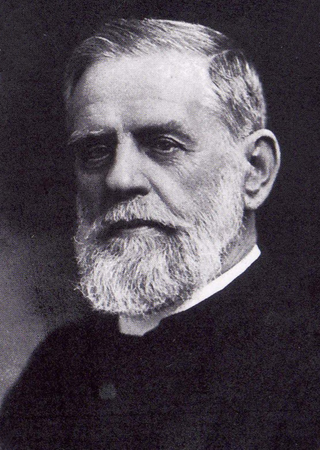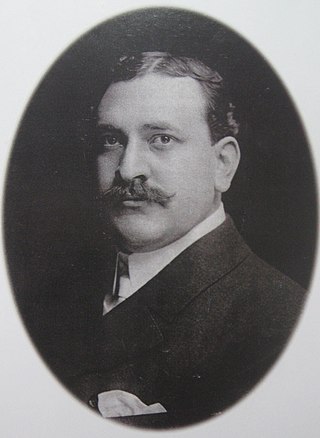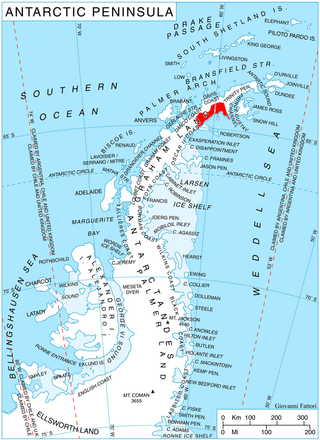
The Arctic Archipelago, also known as the Canadian Arctic Archipelago, is an archipelago lying to the north of the Canadian continental mainland, excluding Greenland and Iceland.

Illiopolis is a village in Sangamon County, Illinois, United States. The population was 891 at the 2010 census. It is part of the Springfield, Illinois Metropolitan Statistical Area.

Lincolnshire is a home rule-class city in Jefferson County, Kentucky, United States. The population was 148 at the 2010 census.

Formosa Province is a province in northeastern Argentina, part of the Gran Chaco Region. Formosa's northeast end touches Asunción, Paraguay, and the province borders the provinces of Chaco and Salta to its south and west, respectively. The capital is Formosa.
Academy Glacier is a major Antarctic glacier in the Pensacola Mountains, draining northwestward between the Patuxent and Neptune ranges to enter Foundation Ice Stream.

The Daewoo Magnus is a mid-sized sedan developed and manufactured by Daewoo for model years 2000-2006 under a single generation, and marketed globably by GM Daewoo and other General Motors divisions, as well as GMDAT stake holder Suzuki. Developed under its internal Daewoo designation V200, the Magnus was marketed prominently in the United States as the Suzuki Verona.

Grenadines is an administrative parish of Saint Vincent and the Grenadines, comprising the islands of the Grenadines other than those belonging to Grenada. The capital is Port Elizabeth.
Dubuc is a village in the Canadian province of Saskatchewan within the Rural Municipality of Grayson No. 184 and Census Division No. 5. The village is located 55 kilometres south of the City of Yorkton and 30 km west of Esterhazy.

The Roman Catholic Diocese of Formosa is a Latin suffragan diocese in the Ecclesiastical province of Brasília in central Brazil.

William Campbell (1841–1921) was a Scottish Presbyterian missionary to Formosa. He wrote extensively on topics related to Taiwan and was also responsible for founding the island's first school for the blind. Interested in the early history of the island, his knowledge of the time was such that he was called "without doubt the greatest authority on this subject living". He was probably the first European to see Sun-Moon Lake, which he named Lake Candidius in honour of the seventeenth century Dutch missionary George Candidius.

James Wheeler Davidson was an American-born Canadian businessman, diplomat, explorer, journalist, and philanthropist. He is remembered for writing The Island of Formosa, Past and Present (1903), a book on the history of Taiwan. He also noted for greatly aiding the internationalisation of Rotary International.
Tres Pozos is a village and municipality in Chaco Province in northern Argentina. Tres Pozos is the place chosen to project a fourth bridge between the provinces of Chaco and Formosa.

The Formosa Expedition, or the Taiwan Expedition of 1867, was a punitive expedition launched by the United States against the Paiwan, an indigenous Taiwanese tribe. The expedition was undertaken in retaliation for the Rover incident, in which the Rover, an American bark, was wrecked and its crew massacred by Paiwan warriors in March 1867. A United States Navy and Marine company landed in southern Taiwan and attempted to advance into the Paiwan village. The Paiwan responded with guerrilla warfare, repeatedly ambushing, skirmishing, disengaging and retreating. Eventually, the Marines' commander was killed and they retreated to their ship due to fatigue and heat exhaustion, and the Paiwan dispersed and retreated into the jungle. The action is regarded as an American failure.

Pyke Glacier is a glacier 5 nautical miles (9 km) long, flowing southward from Detroit Plateau, between Albone and Polaris Glaciers on Nordenskjöld Coast in northern Graham Land, Antarctica. Mapped from surveys by Falkland Islands Dependencies Survey (FIDS) (1960–61). Named by United Kingdom Antarctic Place-Names Committee (UK-APC) for Geoffrey N. Pyke (1894–1948), English scientist who in 1941 originated the ideas developed by the Studebaker Corporation into the M-29 Tracked Cargo Carrier or "Weasel," the first really successful snow vehicle.

Eliason Glacier is a glacier 5 nautical miles (9 km) long close west of Mount Hornsby, flowing south from Detroit Plateau into the ice piedmont north of Larsen Inlet, Nordenskjöld Coast in northern Graham Land, Antarctica. It was mapped from surveys by the Falkland Islands Dependencies Survey (1960–61), and was named by the UK Antarctic Place-Names Committee after the Eliason motor sledge, invented in 1942 in Sweden, now made in Canada, and used in Arctic Canada since 1950 and in the Antarctic since 1960.
Kauffman Glacier is a broad, smooth glacier, 7 nautical miles (13 km) long, flowing eastward into the head of Palmer Inlet on the east coast of Palmer Land, Antarctica. It was mapped by the United States Geological Survey in 1974, and named by the Advisory Committee on Antarctic Names for Thomas A. Kauffman, a United States Antarctic Research Program biologist and Station Scientific Leader at Palmer Station in 1973.
Cha-156 or No. 156 was a No.1-class auxiliary submarine chaser of the Imperial Japanese Navy that served during World War II.
Argyrochosma formosa is a fern known from eastern and central Mexico and Guatemala. It grows on rocky slopes, particularly on limestone. Unlike many members of the genus, it lacks white powder on the underside of its leaves. First described as a species in 1842, it was transferred to the new genus Argyrochosma in 1987, recognizing their distinctness from the "cloak ferns".











